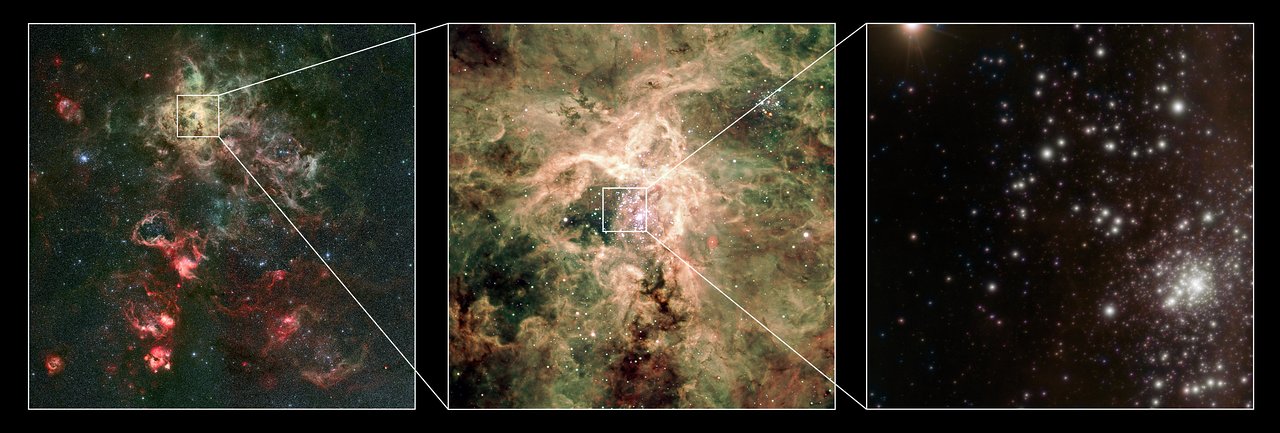New Scientist | Astrophile | Douglas Heaven | 2012 Aug 10
Objects: Four stars in the Tarantula Nebula
Characteristics: big, bright and seemingly impossible
Freakishly huge and uncomfortably bright, a quartet of stars sits huddled in the Tarantula Nebula, outcasts in a universe that says they shouldn't exist.
Nestled in the R136 star cluster, the giants are each around 300 times as massive as our sun. They're surrounded by more conservative neighbours, stars no heftier than 150 solar masses. According to generally accepted norms, that's as big as a star should be.
"The assumption of an upper limit of 150 solar masses has been central to our theory of star formation for a while now," says Sugata Kaviraj at Imperial College London. With no good explanation for their bulk, the stellar anomalies were quickly branded monsters.
Now a band of scientists says these impossible bodies are actually misunderstood. The monsters weren't born big, they simply grew up in a rough neighbourhood and reached outlandish sizes to survive violent clashes.
Monster mash
Sambaran Banerjee and colleagues at the University of Bonn in Germany developed a computer simulation that traced the evolution of a cluster akin to R136, star by star. The model revealed the interactions of more than 170,000 normal-sized stars packed closely together, including standard binary pairs in stable orbits.
In such a crowded environment, stability is short-lived. "The binary's pleasant, peaceful, predictable and periodic circular orbit is perturbed by passing stars, which are plentiful in this rich, dense cluster environment," says Kirk Borne of George Mason University in Virginia, who was not involved in the study.
Sometimes, stars in very close binary orbits would become so erratic that they would smash into each other and merge, giving rise to a monster.
These giants don't appear in every star cluster because cooking them up requires special conditions. The grouping must be dense enough for stars to be especially close, and young enough so that stellar winds haven't yet blown the giants down to standard sizes.
"These massive stars always have strong winds and lose mass rapidly," says Banerjee. "After about 1.5 million years the wind becomes particularly strong and the star enters what is called a Wolf-Rayet phase." By about 2 million years the star will have lost more than half of its mass and will be able to blend in with its normal neighbours.
Paul Crowther of the University of Sheffield in the UK led the project that first weighed the fearsome foursome in 2010. He thinks this is the best simulation done so far, and that the binary explanation is entirely plausible.
However, the results only show that these mergers could happen, not that they have to happen. It's possible, he says, that regular-sized stars managed to consume a lot of extra gas by being in the right place at the right time.
Either way, it's time to stop calling them monsters, says Banerjee, who prefers to think of the giants as "super-stars".
Journal reference: Monthly Notices of the Royal Astronomical Society (in press); arxiv.org/abs/1208.0826
ScienceShot: What Makes a Monster Star?
Science NOW | Ken Croswell | 2012 Aug 09
In 2010, observers reported the most massive stars ever seen, exceeding what many astronomers thought was a ceiling around 150 times the mass of our sun. The most flagrant violator had about twice the legal limit. The heavyweight champs resided 160,000 light-years from Earth in Radcliffe 136 (far right image above), a dense star cluster within the Large Magellanic Cloud, the brightest galaxy that revolves around our own. Now, as astronomers will report in Monthly Notices of the Royal Astronomical Society, they have simulated the evolution of this star cluster, finding that a stellar heavyweight can arise when two massive stars born orbiting each other merge into a single behemoth due to the frequent juggling of other stars in such a dense environment. The idea is plausible, because massive stars usually have partners, but observers need to test the claim by measuring how fast the record-breaking stars spin. If they're really the product of stellar mergers, they should spin fast: As two stars merge, the angular momentum of their orbital motion spins up the single merged star so that it whirls rapidly.
Astronomers crack mystery of the “monster stars"
Royal Astronomical Society | 2012 Aug 07
The emergence of super-canonical stars in R136-type star-burst clusters - Sambaran Banerjee, Pavel Kroupa, Seungkyung Oh
- arXiv.org > astro-ph > arXiv:1208.0826 > 03 Aug 2012
- Monthly Notices of the Royal Astronomical Society 408(2) 731 (Oct 2010) DOI: 10.1111/j.1365-2966.2010.17167.x
arXiv.org > astro-ph > arXiv:1007.3284 > 19 Jul 2010
<< Previous Astrophile

